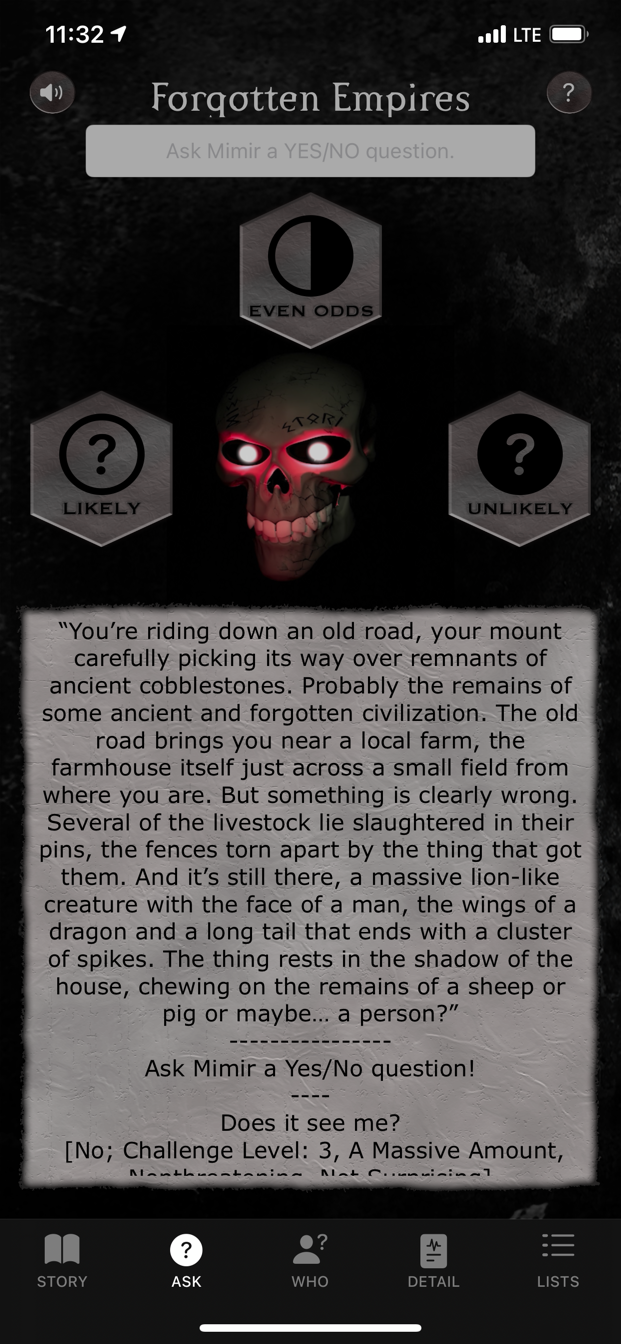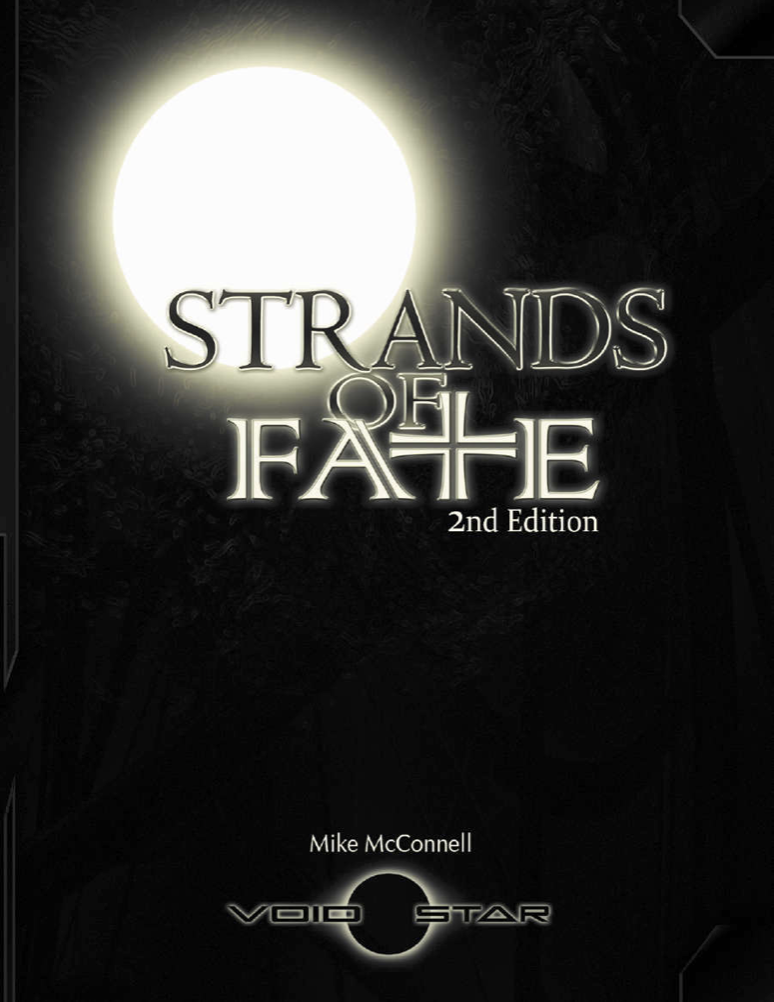Mimir: A (not so) little side project
/So around the time the pandemic started, I had a confluence of ideas that all sort of solidified at once:
I should learn a new skill, preferably something that benefits both my day job and Void Star.
I’ve been interested in maybe going back to school. Maybe for Computer Science this time? Maybe I should go ahead and dip my toes into programming.
Solo-Roleplaying is kind of a neat idea; sort of a cross between solitaire, D&D and a creative writing project. And it seems to be growing in popularity as a result of everyone being locked in.
All of these ideas bounced around in my head until they finally collided and formed into an actual plan. I was going to teach myself to code. And my first project was going to be a phone app designed to aid gamers interested in solo-RPGs. But as these things go, the scope of the app expanded to become a tool for regular GMs running games for players, as well as a way for multiple players to use the app as their GM.
So… blah blah blah.. what am I talking about?
Let me introduce you!
Mimir’s Launch Screen
What is Mimir?
Mimir is a phone app designed to serve a few different purposes. The original intent was to serve as a sort of intelligent "Oracle" for solo-roleplaying. But it quickly grew into something useful for GM's running standard games, as well as for groups who want to play using Mimir as their GM. It also serves up ambient sound to help set the mood and spur the imagination, generates detailed NPCs, generates an array of additional inspirational details, and allows you to build your own custom lists to randomly roll on.
Currently it's being developed as an iPhone app, and is in the first phase of Beta testing.
"What about Android?"
Yeah, I know. A lot of gamers use Android devices. And If the IOS version does well enough I’m going to put some effort into putting together an Android version. But like I said before, the reality is that I'm just starting to learn to code and I still have a rather demanding day job. So I'm not ready to tackle duel-platform development just yet.
"Why just fantasy?"
Originally I started developing Mimir to cover fantasy, modern and sci-fi. But I eventually had to accept that I had to focus on a single era of play if this thing was going to ever actually release. But I absolutely intend to expand into modern and sci-fi as soon as possible.
What does Mimir do?
When you open Mimir for the first time, it will start guiding you though starting a new story. (Story Select Screen) Soon after you'll see the story setup screen. (Story Setup Screen) And as you'd expect, all of the story prompts and details you'll get will be influenced by your selections there. Want to play in Forgotten Realms? You'll want to pick High Fantasy/Traditional. Feel like some Dark Sun? You'll want to go with High Fantasy/Post-Apocalyptic. Is Ravenloft more your thing? Check out Low Fantasy/Horror. Got another brand of fantasy you like? I bet one of these combos will work for you.
The ASK Screen
Mimir works for all fantasy settings, regardless of rules. D&D? Pathfinder? Savage Worlds? Fate? It’s all good. Mimir generates details and inspiration for your setting and NPCs, and doesn’t get caught up in game mechanics.
Once you've made your initial selections, you'll be prompted to answer a simple question about how you want to get started. Do you want start your character(s) just hanging out somewhere, or do you want to get spicy from the start? Once you make that choice, you’re confronted with an introduction. (Intro Text Screen) You are given 2 chances to refresh the intro that's served up to you. But once you're happy with it, hit the green checkmark and then you're ready to get started.
Most of your time with Mimir will be spent on the "Ask" screen. ("Ask" Screen) There is a lot of data here, so there are a few things to point out:
The top field is a place for you to type your Yes/No question for Mimir.
Once you enter your question, you choose how likely you think the answer is to be true. Likely, Unlikely, or Even Odds.
In the top left corner you see a button that opens the ambient sound effects tab. From there you can play mood setting audio for a walk through a forest, a medieval city, a creepy dungeon, etc. (Ambient Sound Selection Screen)
The upper right button is a tutorial that helps players use Mimir as intended. And I’ll be making a downloadable PDF manual available here on the site pretty soon.
Dead center you see Mimir himself. The skull, sporting some fancy Nordic runes, is animated and slowly looks around while this screen is open. Now, notice his eyes. Those are important. Every time the answer to your question comes up some version of "No", his eyes glow a little brighter. And at some point, he triggers a Complication.
The bottom section is a running log of every question and answer you've asked and received. Complications are also inserted into this log. More on Complications below...
When you ask Mimir a question, an answer screen pops up. (Sample Answer Screen) Front and center on this screen you'll see Mimir’s simple answer, which can range though "Yes", "Yes and", "No", and "No but". It also serves up a Challenge Level, which is just a number ranging from 1 to 10 (with a bell curve centered on 5). This Challenge Level can be used to gauge anything from monster strength to how hard it is to pick a lock. It also gives you a Degree and Peculiarity to help further shape the scene. And for further inspiration it serves up a playing card suit and value, an animal, a color, an emotion, a direction, and a Tarot card. The tutorial screen goes over each of these and gives advice for how to use them to guide your story.
A Sample NPC
So what are Complications? If you get too many "No" answers, Mimir's eyes get more red until you finally piss him off enough to hit you with a Complication. Whenever a Complication is triggered, you'll make a couple of selections that help make sure the Complication that gets inflicted on you makes sense within the context of your story. (Sample Complication Screen)
Also, in the next tab you'll find that Mimir also serves up a detailed, randomly generated NPC. (Sample NPC) But let's say you gen up an NPC you love, but maybe you don't care for their profession. You can lock the others entires and re-roll just the values you want to reroll. And when you're happy, if you want, you can save them to view later. (NPC Vault Screenshot)
The next tab is all about helping you fill in detail and generate inspiration of all sorts. Here is a sample screen I generated for you to check out. (Sample Detail Screen)
In the last tab you can create and store your own random lists for stuff more specific to your story. You can make any list you like, and populate it with entries flagged as Common, Uncommon or Rare. These flags will determine how likely a particular entry is to get selected when you tell it to randomly pull something from your list for you. (Custom List Screen) (List Creation Screen)
I think that just about covers it.
Want to Playtest?
We’re accepting playtesters now. So if you have an iPhone, and you want to be a tester, shoot me an email at info@voidstarstudios.com and just write "Mimir Playtest" in the subject line. All I really need is your email address, but if you want to drop some feedback or feature requests in there, I'm happy to hear it. And I'd love to hear what you plan to use if for. Mimir should work with any iPhone 6 or later. It might work on some earlier ones too if you want to give it a shot. But it’s a matter of needing screen-space more than computing horsepower. So beware that it might get pretty cramped.






![Nova Praxis: Savage Worlds Edition [SW]](https://images.squarespace-cdn.com/content/v1/513f57ebe4b0970eaf232dec/1411429136405-VRGAKJO9SF6QPT34HM4E/image-asset.jpeg)

![Machinations: The Nova Praxis GM's Companion [FATE]](https://images.squarespace-cdn.com/content/v1/513f57ebe4b0970eaf232dec/1411429079131-BC5SAOV0KM9HTN3OZBH7/image-asset.jpeg)
![Nova Praxis [FATE]](https://images.squarespace-cdn.com/content/v1/513f57ebe4b0970eaf232dec/1367939683929-QNNP413OLYGL8M41WLW6/NP+Cover+-+Portrait.jpg)
![Nova Praxis Augmented PDF [FATE]](https://images.squarespace-cdn.com/content/v1/513f57ebe4b0970eaf232dec/1363875286527-YO2FZTE5UEEWDRCGJDEL/NP+Cover+-+Portrait.jpg)
![Nova Praxis GM Screen PDF [FATE]](https://images.squarespace-cdn.com/content/v1/513f57ebe4b0970eaf232dec/1364779338460-GU1F5C8859WT56TJP77X/GM+Screen+Cover.jpg)
![Strands of Fate [A FATE Core Rulebook]](https://images.squarespace-cdn.com/content/v1/513f57ebe4b0970eaf232dec/1363875325431-39PZH4IV53HBRVIUSZ22/Strands+of+Fate+Cover.jpg)
![Strands of Power {SoF Supplement]](https://images.squarespace-cdn.com/content/v1/513f57ebe4b0970eaf232dec/1363875360147-J8EQQ90ZOIEOBLSTIEPY/Strands+of+Power+3+1.jpg)
